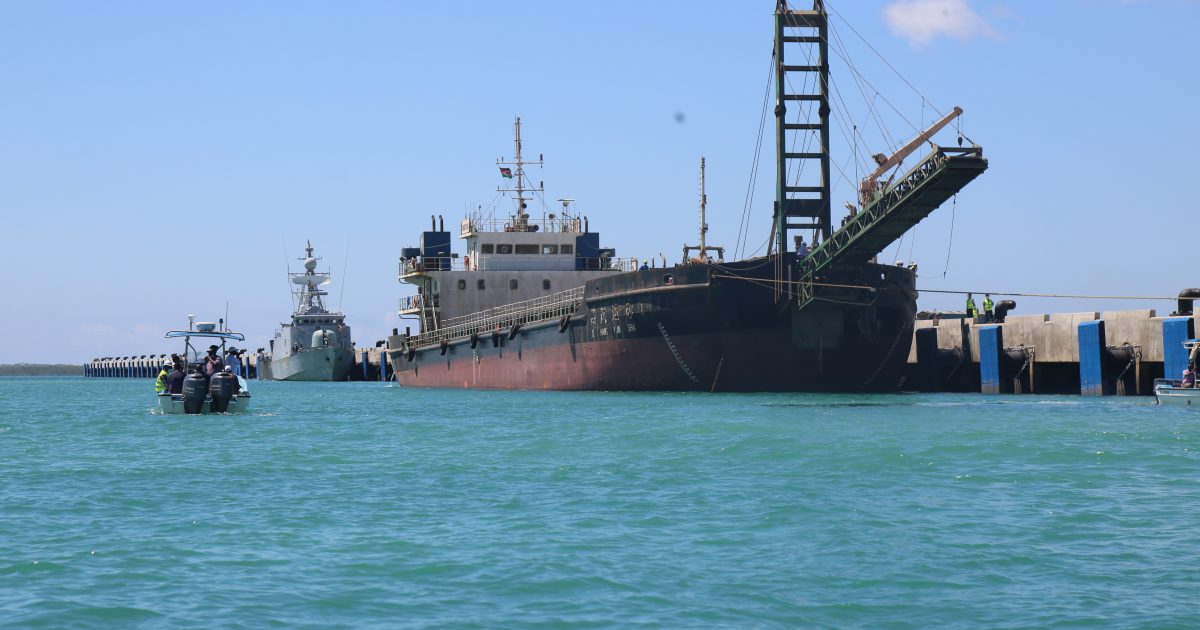Interim operations at the Lamu Port are set to begin in the first berth, with respective agencies tied to port operations having commenced laying the groundwork for full operationalization, once all the three berths are completed later in October this year.
Interim operations will begin on June 15, with the first berth which already has a container yard terminal fully in place to carry out initial logistics operationalization of the Lamu port.
Plans are already underway to secure Sh618 million that would enable the commencement of interim operations at the Lamu Port in two months, while Kenya Ports Authority officials are optimistic over the ports capacity to make use of the one fully completed berth and yard.
This is notwithstanding continued works at the container yard terminals 2 and 3 that stand at 83 percent completion with both berths already complete.
Under the auspices of the Lamu Port Operationalization Secretariat, key agencies tied to port operationalization namely, Kenya Ports Authority, Kenya Revenue Authority, Kenya Bureau of Standards, Kenya Plant Health Inspectorate Service and Port Health, port operationalization is in high gear, despite financial constraints concerns dogging the Vision 2030 project.
“We need Sh5.8 billion by the end of this financial year to ensure that port works for the container yard terminals 2 and 3 are complete,” said Eng. Abuldahi Samatar, General Manager in charge of the Lamu Port project intimates.
He further reveals that there is an urgent need for the National Treasury to disburse Sh5.8 billion in order to prevent the contractor, Chinese Construction and Communication Company from demobilizing and leaving the port site awaiting funding.
KPA officials have revealed that it could cost the taxpayer as much as Sh1 billion to engage the contractor back to work in the event that they leave the site, stressing the urgency for the government to support the project to its optimal completion.
“We remain optimistic that the schedule to interim operationalization of berth 1 will enable stakeholders to realize that the port project is finally coming to fruition,” stated Eng. Dan Amadi, head Lamu Port Development Project.
Eng. Samatar states that with the operationalization of the Lamu Port in June, KPA and LCDA are scheduled to send a high level marketing team is set to go to Ethiopia in a bid to offer them a better logistics deal in comparison to the one they may be getting from the port of Djibouti or the Port of Massawa in Eritrea.
“Being a new port, there is need to incentivize the Lamu Port with better tariff rates that would make it competitive in the regional and global logistics market,” notes Samatar.
To promote traffic into the new Port, KPA have already put in place an extended a 30-day storage free period for transshipment and transit cargo, 14 days’ storage free period for domestic cargo and a 40 per cent discount for cargo-based charges as per the KPA tariff.
“Light dues, port and harbour dues shall be charged once at the first port of call in the country, at either Lamu or Mombasa with Coasters carrying transshipment cargo from Lamu to Mombasa being offered a 40 per cent discount on the cargo handling charges,” a KPA management statement offers.
KPA had in July 2019 managed to convince more than 10 shipping lines to visit the port in a marketing strategy, aimed at attracting vessels to Lamu underscoring the Lamu Port management’s commitment to ensuring port operationalization takes shape.
Eng. Samatar however admits that even with the interim operationalization of the Lamu Port project, operations are likely to be restrictive due to the lack of Ship to Shore (STS) Gantry cranes needed to enable unloading of goods from ships.
The senior KPA official further discloses that it could cost KPA as much as Sh.18 billion to acquire 12 new STSs required for the full operationalization of the Lamu Port.
The equipment needed includes Rubber-Tyred Gantry cranes (RTGs), terminal tractors, forklifts and reach stackers (for container handling) and pilot boats, tag boats and mooring equipment for handling of vessels.
The authority had in July 2019 called for supply of three-six tonne and two-five tonne forklifts. KPA is also installing navigation aids at the port.
“One berth however would need four STSs, and there are already plans to ferry some older cranes initially to aid in the interim operationalization of the Lamu Port,” he adds.
According to logistics experts, it could take as long as 18 months to procure and install new STS gear, with KPA officials intimating that the ships that will initially dock at the Lamu Port will be those with their own gantry equipment.
“The ships that will dock and be serviced at the Lamu Port will be by appointment and being that there are very few ships with their own STS equipment,” Samatar adds.

Photos by Amenya Ochieng.
“The Lamu Port will initially be a transshipment hub, for the region, with expectation high despite the global financial constraints that port operation will pick up and compete on a regional and grow into a global scale,” Abdishukri Osman, Lamu Port Superintendent reaffirms.
With more than 87 percent of the 135 kilometer Lamu-Garsen road, the main road connecting Lamu to the rest of the coastal region and other parts of Kenya, tarmacked, optimism is high that the LAPSSET project is finally taking shape especially with the deployment of more security resources to tackle terrorism.
“The scale of security personnel and resources that the national government has deployed to Lamu with regards to affirming stakeholder concerns over road safety of goods and trucks is unprecedented,” Lamu County Commissioner Irungu Macharia states.
He adds that significant steps and measures have been taken especially with the tarmacking of terror hotspots namely; Milihoi and Nyongoro and more security personnel by way of GSU and KDF setting up camp close to these areas in a bid to fight terrorism.
“For more than two years now, there have been no IED attacks on the Sh. 10.8 billion Lamu-Witu-Garsen road that is likely to be completed by end of this year,” Macharia states.
“Besides improving security and tarmacking the Lamu Witu road, there has also been a need to secure the Lamu Port itself not only from terror attacks but also from land encroachment and invasions, which are likely to be attempted once the Lamu port becomes operational,” he adds, stating that there are already significant steps being taken to ensure that land belonging to the Lamu Port remains untouched for further expansion of the port.
“We expect a lot of interest to come to the county once the Lamu Port becomes operational, especially with regards to land management issues,” he observes, adding that the national and County governments will work together to ensure that the County Spatial Plan is adhered to.
The sentiments are echoed by Lamu Police Commander Moses Muriithi, who reiterates that security has also been enhanced in and around the port area in a bid to ensure that the port project is a success.
By Amenya Ochieng





